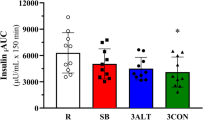Abstract
The purpose of this study was to evaluate the role of exercise intensity in the effect of physical training on insulin sensitivity. The insulin tolerance test (ITT) was applied to quantify insulin sensitivity. Eighteen healthy, young, untrained men and women participated in a 4-week, five times per week, 1-h per session bicycle-ergometer training program. Training consisted of 3-min bouts of cycling interspersed with 2 min at a lower exercise intensity. Intensities were 80 and 40% of pretraining maximal power output (W˙ max) in the high-intensity (HI) and 40 and 20% W˙ max in the low-intensity (LI) group. The insulin sensitivity index (ISindex) was similar in the HI and LI group before the training intervention [mean (SD) −0.1898 (0.058) and −0.1892 (0.045), respectively]. After training, the ISindex was −0.2358 (0.051) (P = 0.005 vs pretraining) in the HI group and −0.2050 (0.035) (P = 0.099 against pretraining) in the LI group. We conclude that improvements in insulin sensitivity are more pronounced with high-intensity training, when exercise frequency and duration are kept similar. We further conclude that the ITT is suitable for use in intervention studies.
Similar content being viewed by others
Author information
Authors and Affiliations
Additional information
Accepted: 5 May 1999
Rights and permissions
About this article
Cite this article
Borghouts, L., Backx, K., Mensink, M. et al. Effect of training intensity on insulin sensitivity as evaluated by insulin tolerance test. Eur J Appl Physiol 80, 461–466 (1999). https://doi.org/10.1007/s004210050618
Issue Date:
DOI: https://doi.org/10.1007/s004210050618




